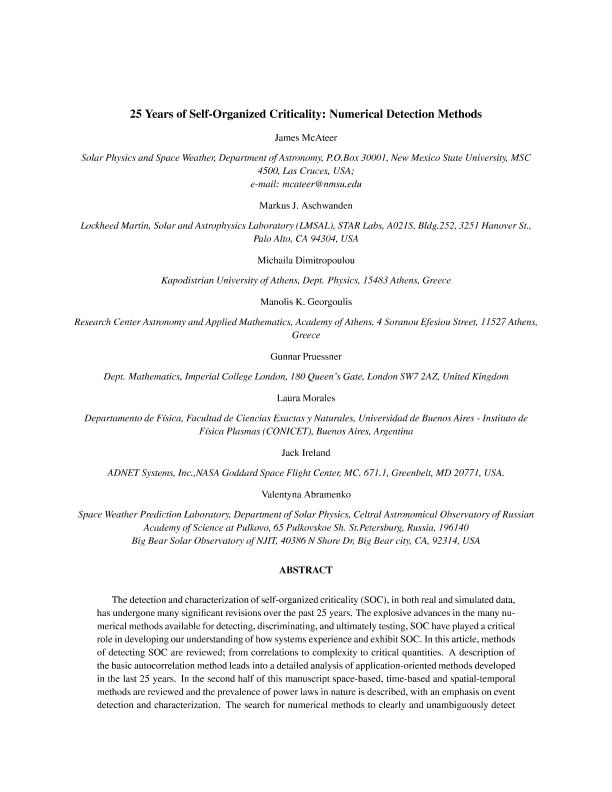Mostrar el registro sencillo del ítem
dc.contributor.author
McAteer, James

dc.contributor.author
Aschwanden, Markus J.

dc.contributor.author
Dimitropoulou, Michaila

dc.contributor.author
Georgoulis, Manolis K.

dc.contributor.author
Pruessner, Gunnar

dc.contributor.author
Morales, Laura Fernanda

dc.contributor.author
Ireland, Jack
dc.contributor.author
Abramenko, Valentyna
dc.date.available
2019-07-05T16:38:23Z
dc.date.issued
2015-05
dc.identifier.citation
McAteer, James; Aschwanden, Markus J.; Dimitropoulou, Michaila; Georgoulis, Manolis K.; Pruessner, Gunnar; et al.; 25 Years of Self-organized Criticality: Numerical Detection Methods; Springer; Space Science Reviews; 198; 1-4; 5-2015; 217-266
dc.identifier.issn
0038-6308
dc.identifier.uri
http://hdl.handle.net/11336/79253
dc.description.abstract
The detection and characterization of self-organized criticality (SOC), in both real and simulated data, has undergone many significant revisions over the past 25 years. The explosive advances in the many numerical methods available for detecting, discriminating, and ultimately testing, SOC have played a critical role in developing our understanding of how systems experience and exhibit SOC. In this article, methods of detecting SOC are reviewed; from correlations to complexity to critical quantities. A description of the basic autocorrelation method leads into a detailed analysis of application-oriented methods developed in the last 25 years. In the second half of this manuscript space-based, time-based and spatial-temporal methods are reviewed and the prevalence of power laws in nature is described, with an emphasis on event detection and characterization. The search for numerical methods to clearly and unambiguously detect SOC in data often leads us outside the comfort zone of our own disciplines—the answers to these questions are often obtained by studying the advances made in other fields of study. In addition, numerical detection methods often provide the optimum link between simulations and experiments in scientific research. We seek to explore this boundary where the rubber meets the road, to review this expanding field of research of numerical detection of SOC systems over the past 25 years, and to iterate forwards so as to provide some foresight and guidance into developing breakthroughs in this subject over the next quarter of a century.
dc.format
application/pdf
dc.language.iso
eng
dc.publisher
Springer

dc.rights
info:eu-repo/semantics/openAccess
dc.rights.uri
https://creativecommons.org/licenses/by-nc-sa/2.5/ar/
dc.subject
Numerical Methods
dc.subject
Self Organized Criticality
dc.subject.classification
Astronomía

dc.subject.classification
Ciencias Físicas

dc.subject.classification
CIENCIAS NATURALES Y EXACTAS

dc.title
25 Years of Self-organized Criticality: Numerical Detection Methods
dc.type
info:eu-repo/semantics/article
dc.type
info:ar-repo/semantics/artículo
dc.type
info:eu-repo/semantics/publishedVersion
dc.date.updated
2019-06-21T14:53:02Z
dc.journal.volume
198
dc.journal.number
1-4
dc.journal.pagination
217-266
dc.journal.pais
Alemania

dc.journal.ciudad
Berlin
dc.description.fil
Fil: McAteer, James. New Mexico State University Las Cruces;
dc.description.fil
Fil: Aschwanden, Markus J.. Lockheed Martin Corporation;
dc.description.fil
Fil: Dimitropoulou, Michaila. University Of Athens;
dc.description.fil
Fil: Georgoulis, Manolis K.. Academy Of Athens;
dc.description.fil
Fil: Pruessner, Gunnar. Imperial College London; Reino Unido
dc.description.fil
Fil: Morales, Laura Fernanda. Universidad de Buenos Aires; Argentina. Consejo Nacional de Investigaciones Científicas y Técnicas. Oficina de Coordinación Administrativa Ciudad Universitaria. Instituto de Física de Buenos Aires. Universidad de Buenos Aires. Facultad de Ciencias Exactas y Naturales. Instituto de Física de Buenos Aires; Argentina
dc.description.fil
Fil: Ireland, Jack. Nasa Goddard Space Flight Center; Estados Unidos
dc.description.fil
Fil: Abramenko, Valentyna. Pulkovo Observatory, Russian Academy Of Sciences;; Rusia
dc.journal.title
Space Science Reviews

dc.relation.alternativeid
info:eu-repo/semantics/altIdentifier/doi/http://dx.doi.org/10.1007/s11214-015-0158-7
Archivos asociados
